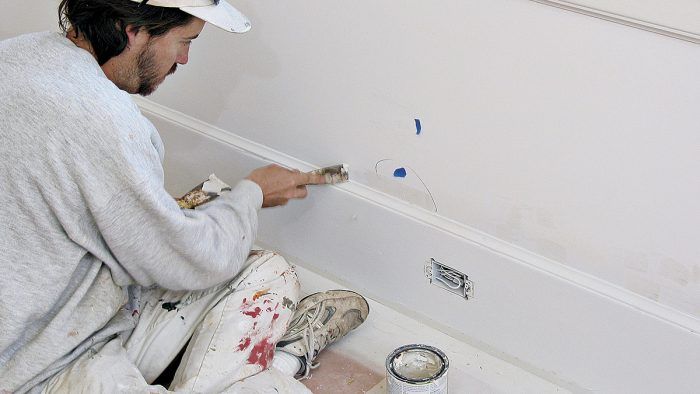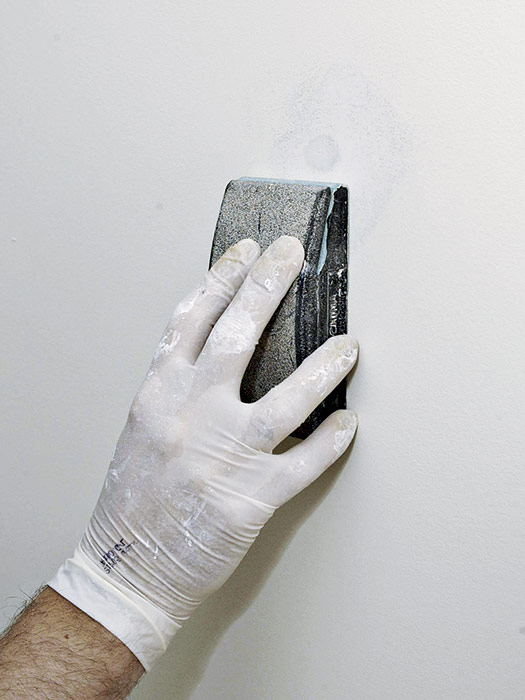Getting Ready to Paint
Previously painted and unpainted surfaces require somewhat different preparation strategies.

When painting interiors, it’s best to move the furniture out. If that’s not possible, group it in the center of the room and cover it with a plastic tarp. Remove drapes, wall hangings, and mounting hardware, and fill holes. Turn off electric power to the room—use a voltage tester to be sure it’s off—and remove the cover plates of electrical outlets and switches. Light fixtures or hardware left in place should be masked off or wrapped in plastic. Finally, cover the floor with canvas drop cloths—plastic is too slippery to work on.
Previously painted surfaces don’t need much preparation if the surface is intact: Sand lightly with 150-grit sandpaper or a sanding block. If paint is flaking or loose, remove it with a paint scraper or spackling knife. Then sand rough paint edges with 120-grit to 150-grit sandpaper. Use spackling compound to fill holes, and sand it when dry. Apply a bead of paintable caulk (acrylic latex) to fill gaps where the trim meets walls, smoothing it with a moist finger. Caulking makes the finished paint look much better.

| PRO TIP: If you see water stains, widespread peeling, mold, or large cracks that suggest structural movement, attend to the underlying causes first. |
After sanding, dry-mop or vacuum surfaces to remove dust. Then sponge-wash them with a mild detergent solution and rinse with clear water. If the walls are especially greasy (kitchen walls, for example), use a more aggressive cleaner like trisodium phosphate (TSP). After rinsing, allow walls to dry thoroughly before painting. A good test of dryness is to check whether a piece of transparent tape will stick or not.
| Skin CareTo minimize paint contact with your skin, (1) wear goggles, especially when using chemical strippers; (2) use an extension pole so you don’t need to stand immediately beneath a roller; (3) don’t overload brushes and rollers; (4) brush or roll away from your face, especially on the first few strokes after loading up with paint. |
On Priming Painted SurfacesPrimers bond to substrates and provide a stable base for finish coats. It’s wise to prime previously painted surfaces in the following situations:
Before applying primer, scrape, fill, sand, wash, and rinse the surface, and allow it to dry thoroughly. In general, like bonds best to like. That is, latex paint bonds best to latex primer, oil based to oil based. But a quality acrylic latex primer is a good all-purpose choice because it bonds well and suppresses water stains, crayon marks, smoke, rust, and creosote. However, if you get severe bleed-through, switch to an oil-based sealer-primer instead.
Stickability Test Here’s how to test old paint before selecting a new paint to ensure that the new paint will stick:
|
Unpainted drywall and plaster must always be primed. You can prime drywall as soon as the final topcoat of joint compound has dried and has been sanded. Some pros still prefer an oil-based primer for drywall, but today’s acrylic latexes seal as well and are far easier to clean up.
Plaster surfaces must be cured thoroughly before painting. Although latex primers can be applied as soon as the plaster is dry to the touch, it’s better to wait three to four weeks. Latex paint allows some migration of moisture, so plaster can continue to “breathe off” water vapor. Restorers familiar with plaster recommend diluting latex primer 15% with water so the coating is thinner and even more permeable.
Oil-based paints are another story. Because the alkali in plaster can remain “hot’’ for up to three months, wait that long before using oil-based paints. Otherwise, free alkali in the plaster will attack the paint. Alkaline-resistant primers formulated for new plaster may shorten your wait somewhat, but they must be special-ordered. Before ordering, make sure that the primer will be compatible with the paint.






View Comments
This article is referring to painted drywalls not wood...I hope. There are many more safety issues with lead paint on wood. Read the other articles listed here.